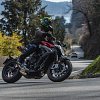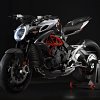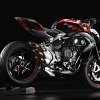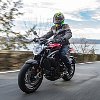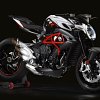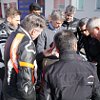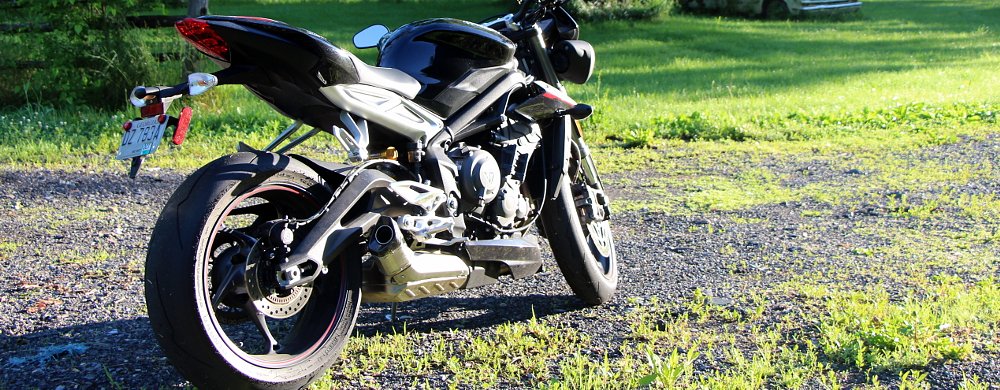The MV Agusta factory is on the shore of Lake Varese, at the base of the Alps just a few minutes from the Swiss border. Brutales — and all the other MVs — are assembled in a clean, modern plant even though the buildings themselves are funky; it used to be a seaplane factory.
There’s a terrific sense of the storied MV racing history everywhere in the plant and the small corporate office complex. I toured the factory on my own prior to the launch, and the guy who does the final visual quality control check of each motorcycle has a work station lined with photos of Giacomo Agostini and other racers from MV’s Grand Prix heyday.

So, in terms of stories, it was cool that MV decided to invite journalists to the factory for the launch of the 2018 Brutale 800 RR. We spent a day riding it on what amounted to a lap of an even bigger lake, Lago Maggiore; we even briefly crossed into Switzerland.
The scenery was spectacular. The only downside was, although the mountains around Varese are rugged, the area’s both quite industrialized and heavily populated, and it also attracts a lot of tourists — even on a weekday in March. So most of our day was spent passing hundreds of cars on winding two-lane roads, usually with very poor visibility, often right on the centerline between cars traveling in both directions, at about two and a half times the posted speed limits.

If we’d ridden that way in the States, our day would’ve ended like the last scene of “The Blues Brothers.” But, in Italy, things like speed limits and solid “no passing” lines between lanes must just be suggestions, because more than once we flew around a corner to find a Caribinieri watching traffic, and they just ignored us.
Over the course of the whole day, we saw one guy getting a ticket. I passed the scene so fast that all I really saw was that the bike was red. It did make me wonder: What the heck did that guy do to warrant actually being pulled over?!? Later, during our lunch break, one of the MV guys mentioned that the guy who got stopped was on a new four-cylinder Panigale. Maybe the cop just wanted to see his bike.
As hard as we tried, we didn’t come close to exploring the limits of the Brutale 800 RR’s capabilities. If there was one thing every journalist present agreed on, it was that the RR should’ve had a track launch. (Actually, we agreed on two things; everyone unanimously liked the food, as well.)

In the meantime, what about the bike?

The 2018 MV Agusta Brutale 800 RR
Chassis-wise, the new 800 RR sticks to the current MV style by mating a steel trellis frame to stout alloy plates, which hold an alloy swingarm.
Brian Gillen, MV’s head of R&D, is an ex-pat American. He told me that while the frame looks almost identical to the previous RR’s frame, the trellis is slightly longer and rake and trail figures are slightly lazier.
“We developed the previous RR on the race track, at tracks like Misano that are very smooth,” he said, while he waggled an imaginary handlebar for emphasis. “It worked great under those conditions, but it could be a little intimidating on ordinary roads unless you were really ready for it.”

Other key cycle parts are a Marzocchi fork and Sachs shock, both of which are adjustable for spring preload, and compression and rebound damping. The front brakes are the usual suspects: radial-mount four-pot Brembo calipers grab 320 mm discs. Interestingly, the brake master cylinder is a Nissin product. In Europe and many other markets, ABS is now mandatory; a Bosch “Nine +” ABS system stands ready to help out in extreme situations. (It goes beyond what’s required, with a rear-wheel lift mitigation system, too.)

The inline triple — a motor that was developed back when Harley-Davidson briefly owned MV from 2008-10 — has been refined since it first appeared in 675 cc form for the 2012 model year. Even now, six years on, the only change to the basic castings is revision to the front engine mount, allowing the stressed-member motor to contribute more torsional stiffness to the frame.
It’s a densely packaged, narrow motor; there’s not enough meat in the cylinder walls or space between the cylinders to bore it out, so the increase in displacement to 800 cc came from a revised crank with a longer stroke.
Since they stroked it, it is no surprise that the standard Brutale, which makes about 100 horsepower, has a nice flat torque curve. The RR model, however, makes 40 percent more power, thanks to revised cams and different throttle bodies with twin injectors. Again, as you’d expect, that results in a steeper and more aggressive-looking dyno chart.
For 2018, the 800 RR had to meet Euro 4 regulations, which are far stricter both in terms of exhaust emissions and sound. Brian Gillen told us that MV went to great lengths to identify and minimize mechanical noise. For example, the cylinder heads now have a new bolt which serves only as a harmonic damper. By cutting mechanical noise by 1.5 dB, MV was able to let the exhaust breathe that much more freely.
Many of the detail improvements — and some of the most impressive aspects of the new RR — relate to the ride-by-wire system, ECU, and traction control. As you’d now expect, you can toggle between rain, normal and sport riding modes, but the MV system also offers a “custom” setting, allowing users to tweak things like the amount of engine braking and maximum allowable torque to suit their own taste and riding style. The traction control system has eight presets. Even the throttle return spring pressure was tweaked after customers found that the earlier ride-by-wire throttle was too easy to accidentally jiggle on bumpy roads.

Another sweet user-interface feature is a standard-equipment quick-shifter that MV calls “EAS 2.0.” It momentarily cuts the throttle for almost seamless upshifts, as well as auto-blipping the throttle for downshifts (although that feature is only available above 30 kilometers an hour.)
Riding the MV Agusta Brutale 800 RR
Sitting on the bike, the first thing I noticed was that the seat was basically a thinly upholstered board. That’s not necessarily bad on a bike that you might want to move around on, so you can hang off. The seat height is fairly high and the edges of the seat created a pressure point on my leg adductors as I just sat there with my feet on the ground.
Luckily, after a week that began with snow and freezing temperatures and ended with cold, heavy rain, our ride day dawned clear. Still, the ride began on brand-new Pirelli Diablo Rosso III tires on cold asphalt that was occasionally damp, at ambient temperatures in the 40s (Fahrenheit).
So, caution was definitely in order. Not that we were cautious. It was just in order.

I wasn’t even off the factory property before I realized that MV wasn’t kidding when they said the bike was easy to turn. One of the choices Harley-Davidson (!) made when it began developing the triple platform was to make a counter-rotating crankshaft. That and very light cast wheels (they weigh about the same as forged aluminum hoops) result in minimal gyro effect.
The first time I crossed a manhole cover that had sunk a couple of inches, I realized that the stock suspension settings were a bit too stiff for a lightweight like me, but that is presumably easy to dial down. Other than that, the Brutale was quite comfy — especially for a bike with no windscreen. The footpegs allowed me to ride without fear of deep-vein thrombosis. My only real ergonomic critique is, the lower part of the fuel tank, where I sometimes like to apply leg pressure, had some bumps and shapes to it that distracted me.
The mirrors were functional, in spite of a detectable (not objectionable) vibration. Unfortunately, the tach was so hard for me to read at a glance that I cannot tell you where, in the rev range, it occurs. MV uses the same dash with a linear tach on other models. The tach’s a sort of bar graph that extends about 3,000 rpm past the point where the Brutale’s rev limiter kicks in.
Although I can’t say I ever felt the traction control or ABS kick in, I did trigger the rev limiter a few times. The standard Brutale is torquey and happy at low revs, but the RR cries out for more revs — that’s where it feels best and sounds fantastic.

After what felt like hours in heavy traffic and a frustrating photo session on steep, slipping-the-clutch-in-first hairpin turns, the sun had finally warmed the asphalt, and after lunch we came upon some fast, flowing sections that were relatively free of traffic.
That helped clarify a few things: First, although I suppose that nowadays, an 800 cc triple is nominally a middleweight, the RR makes very, very good power. Second, the gearbox on the new bike has been tweaked. (If I heard right, the undercuts are different though I admit to not knowing what the difference is.) It would be a nice ’box even without the quickshifter. The quickshifter makes it fantastic, and it would be really, really easy for me to get hooked on the auto-blip feature when downshifting. I found that I could trail brake and downshift, even deep in corners, without upsetting the chassis.

Pushing the bike a little harder on some fairly sketchy asphalt — especially when I encountered a few very small crests when accelerating off corners — also made me appreciate the frame changes MV made for a little more stability, and the fact that the RR comes with a tidy little adjustable steering damper.
One thing that really impressed me is that in a route that must’ve covered well over 100 miles, the fuel gauge still showed a lot of fuel available when we got back to the factory. Meeting Euro IV regulations costs manufacturers a lot of money in R&D, but one unintended consequence is that bikes that meet the new rules get terrific fuel mileage.

I’ll write more soon about MV Agusta’s “hyper-premium” brand strategy going forward. Giovanni Castiglioni was open when talking about the company’s plans to solve inventory, quality control, and parts-availability problems. He knows those issues have hit U.S. customers extra hard over the last couple of years, and he’s pretty convincing when he says it’s turned the corner.
For now, I’ll leave you with this: MV tells me that in the United States the 2018 Brutale 800 RR will carry an MSRP of $16,698. The Triumph Street Triple RS, which leaps to mind as the most obvious and direct competitor, sells for thousands less. The MV makes significantly more power, though the only way to know which one is better or faster would be to compare them back to back.
For what it’s worth, the new Brutale RR is beautifully made, with impressive fit and finish. I like its looks but don’t love them, but as they said in Rome, “De gustibus non est disputandum” — in matters of taste, there can be no disputes; you have to decide for yourself. If it was priced competitively with the Triumph, I’d probably end this review right here by noting once again the very impressive motor, mated to a frame that responds to rider input almost perfectly. But…
Nit-picking or asking for your money’s worth?
After listening to hours of talk about how MV is repositioning its brand even further up-market, and after riding the Brutale for a day in often-frustrating but varied conditions, I sat in the hotel bar, reviewing my notes and mulling the RR’s nearly $17,000 sticker price. I realized I had a few niggling doubts.
Marzocchi and Sachs may well be capable of building top-quality suspension components; my only complaint was that preload settings were probably too heavy for me as a rider. But, those are brands I associate with motorcycles built to a price. The brakes were flawless in my experience, but wouldn’t most hyper-premium customers prefer to have their Brembo calipers matched to a Brembo master cylinder?
MV is proud of the ABS and TC systems on the Brutale RR. Their functionality may indeed be comparable to systems based on an Inertial Measurement Unit; I certainly did not detect any weaknesses in those systems in my one day on the bike. But I still think the absence of an IMU is conspicuous at the price point.

Last, but not least, I’ve got a feeling that MV’s stylist, Adrian Morton, loves that tiny, tiny dashboard. But on a modern bike with myriad permutations of drive modes and traction control, thin-film transistor panel (like the one on the competing Triumph) would make navigating those menus easier for users.
Do you agree with my nit-picking? Or, do you see the Brutale RR as a mobile work of art with a class-leading motor?
Either way, it will be an exclusive bike in the U.S. market, by definition. MV only expects to sell a few hundred bikes across its entire range and the whole country this year. Don’t worry about seeing another guy on the same bike at Starbucks on Sunday morning.





